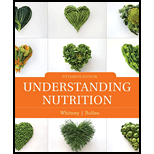
Concept explainers
Which is the better choice—to eat processed foods that have been enhanced with phytochemicals or to eat natural foods that are rich in phytochemicals?
To determine: The better choice among, “to eat processed foods that have been enhanced with phytochemicals” or “to eat natural foods that are rich in phytochemicals”.
Concept introduction: Phytochemicals are naturally occurring plant chemicals that are produced either through primary or secondary metabolism. In foods, phytochemicals impart colors, aromas, tastes, and other characteristics. Several phytochemicals have biological activity in the body. Some examples for phytochemicals include carotenoids, flavonoids, terpenes, and so on.
Explanation of Solution
Eating natural foods that are rich in phytochemicals will help as follows:
- Avert DNA damage and promote DNA repair.
- Immune system stimulation for eliciting proper and quick immune response against invading pathogen.
- Hormone regulation.
- Phytochemicals helps to release toxic substances and potential carcinogens from the body.
- Prevent inflammations and oxidative damage that leads to cancerous cells.
- Altering the growth rate of cancerous cells.
- Regulate the damaged cells to induce apoptosis.
Want to see more full solutions like this?
Chapter 13 Solutions
Understanding Nutrition (MindTap Course List)
- Which of the following statements is incorrect? a. Pigments absorb light of certain wavelengths only. b. Many accessory pigments are multipurpose molecules. c. Chlorophyll a is green because it absorbs green light.arrow_forwardThe movement of mineral nutrients through organisms and their environment is called a __________cycle. biological bioaccumulation biogeochemical biochemicalarrow_forwardNitrogen deficiency stunts plant growth and causes leaves to turn yellow and then die. Why does nitrogen deficiency cause these symptoms? Hint: Think about which biological molecules incorporate nitrogen atoms.arrow_forward
- For an element to be regarded as essential, all of the following criteria must be met, except: No other element can perform the function The element is directly involved in plant nutrition The element is inorganic The plant cannot complete its lifecycle without the element.arrow_forwardWhich factors affect soil quality? chemical composition history of the soil presence of living organisms and topography cl. all of the abovearrow_forward
 Understanding Nutrition (MindTap Course List)Health & NutritionISBN:9781337392693Author:Eleanor Noss Whitney, Sharon Rady RolfesPublisher:Cengage Learning
Understanding Nutrition (MindTap Course List)Health & NutritionISBN:9781337392693Author:Eleanor Noss Whitney, Sharon Rady RolfesPublisher:Cengage Learning Biology: The Dynamic Science (MindTap Course List)BiologyISBN:9781305389892Author:Peter J. Russell, Paul E. Hertz, Beverly McMillanPublisher:Cengage Learning
Biology: The Dynamic Science (MindTap Course List)BiologyISBN:9781305389892Author:Peter J. Russell, Paul E. Hertz, Beverly McMillanPublisher:Cengage Learning Biology (MindTap Course List)BiologyISBN:9781337392938Author:Eldra Solomon, Charles Martin, Diana W. Martin, Linda R. BergPublisher:Cengage Learning
Biology (MindTap Course List)BiologyISBN:9781337392938Author:Eldra Solomon, Charles Martin, Diana W. Martin, Linda R. BergPublisher:Cengage Learning





